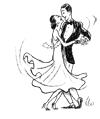|
|
Foxtrot Bounce
by Harold & Meredith Sears
We know about Samba Bounce. For
instance, in a Samba Walk (1a2) we step forward with a little pelvic
tilt forward and with compressed knees. We are "down." On
the "a" we place the trail foot behind with a little pelvic
tilt back and straighten the knees. We are up to a normal height.
Then we pull the lead foot back about three inches with no pelvic
tilt and compress once again. The Samba Bounce is down-a-down. The
action is soft and light.
But what about a Foxtrot Bounce?
In the
Smooth rhythms, we are usually encouraged to rise and fall over the
measures of music but are warned not to bounce on each beat.
Controlled rise and fall is smooth, graceful, and pretty.
Unintentional bounce will probably be sharp and jerky, rough, not
pretty---maybe like a youngster walking with one foot on the curb and
the other in the gutter---up, plop, up, plop . . .
But quite a few foxtrots do call
for
some bounce, and it can add a light gaiety to a fun dance.
In A Smile and A Wink by
the
Broadwaters, we do a Hover to Semi and then a Bounce Feather
in 5 (sqqqq). We step through lowering, side and forward left rising
(W sd & bk R turning to banjo), and then three more steps: down,
up, down, ending in feather position. In Au Revoir by the
Fishers, we have a Curved Feather Checking to a Bounce Back
Feather in 4 (s&s&). The steps are simply back, back,
back, back, but again, we are down, up, down, up.
In 16 Tons by the
Blackfords,
there is a Whiplash to banjo with left sway and open head, and then
we do a simple Bounce Sway Change. We sharply rise, lower,
rise, and lower, as we change from left to right sway, closing the
woman's head. There are no steps. Then we dance a quick back Feather
Finish in 4; Reverse Wave.
In Milica 4 by the
Woodruffs.
there is a Twisty Vine 8 with Bounce. On all the side steps,
we are up, and on all the crossing steps we soften the knees and drop
down.
Let's think about the Bounce
Reverse
Fallaway (qqs). In closed position or in banjo, facing line and
center, we step forward on the left foot (W back R) turning left-face
and with strong rise, side R DLC but body facing DRC (W back L)
sharply lower, back L with sharp rise (W bk R) to semi-closed
position facing reverse.
In order to emphasize or to
showcase the bounce, this figure is
often done in 4 steps (qqqq): "bounce reverse fallaway in 4"
or "bounce reverse fallaway and back." An additional back
step on the trail feet is taken. Another slight modification that
emphasizes the "up" part of the bounce is to dance the
figure s&s&. With this timing, we rise on the slow-counts and
hold the up position just a little, and then fall quickly on the
&-counts. In Ain't That A Kick by the Cantrells, we do a
feather finish; change of direction; bounce reverse fallaway &
back to BJO DRW; to a weave ending.
And finally, there is the Bounce
Reverse Fallaway & Slip, an advanced figure but one of the
more common examples of Bounce. As discussed above, we usually dance
this figure not sqq but qqqq or even s&s&, to showcase the
bounce. This time, in closed position or banjo facing DLC, the man
steps fwd L (W bk R) turning LF and with strong rise, sd R DLC but
body facing DRC (W bk L) sharply lowering, bk L with sharp rise (W bk
R) to semi-closed position facing reverse, and then the man slips his
R past his L toeing in to a small back step R (woman fwd L pulling
her left shoulder strongly back) with LF body rotation, and turns 1/4
more LF softening R knee to closed position facing line and wall. In Smoke
Gets In Your Eyes by the Rumbles, the dance starts
with a Bounce Reverse Fallaway Slip; Change of Direction;
Telefeather;; In French Poodle by the Moores, there is a
three step; natural hover cross overturned to BJO DRW; top spin to
BJO DLC; bounce fallaway & slip; change of direction.
Foxtrot is not Samba, but
sometimes, a
Bounce makes it a little more of a party.
A version of this article was
published in the Washington Area Square Dancers Cooperative Association (WASCA) Calls 'n' Cues, 50-10:9, 6/2010.

If you would like to read other articles on dance
position, technique, styling, and specific dance rhythms, you may visit
the article TOC.
Past DRDC Educational Articles archived here.
Go beyond this site. Find other references on our Sources and Links
pages.
|

